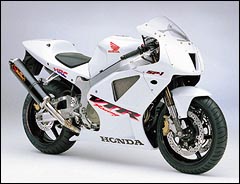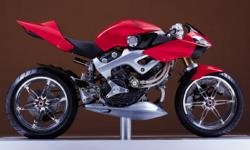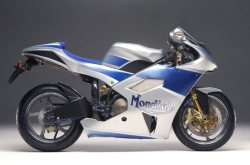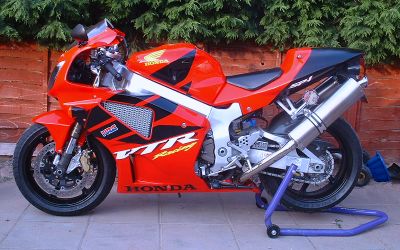Honda VTR1000 SP-1 / SP-2 (RC51)
This is Honda's latest weapon in the World Superbike wars. The RC45, while eventually making it to championship winner in 1997, was still considered inferior to Ducati's 916. Honda decided to play Ducati at their own game. The original VTR1000 was developed purely as a road bike, and has been thought of by many as a "VFR with only two cylinders". So Honda produced a v-twin update of the RC45. It is a 90-degree 9-valve v-twin, and has fuel injection. Honda claimed to have borrowed the NSR500's frame during testing. It won the World Superbike championship in its first year with Colin Edwards on board.
July '00 - Suzuka 8-hour
A factory RC51 won the most prestigious race of the year in the hands of 250cc GP rivals Tohru Ukawa and Daijiro Kato. Colin Edwards and Valentino Rossi went out on lap 125 when Edwards crashed. The two stars had looked like the fastest pairing on the circuit, but Ukawa and Kato saved the day for Honda. Honda v-fours were consistent winners in endurance racing, so Honda will have been pleased that the new v-twin picked up where the previous bikes left off.Joey's TT-winning RC51
This hybrid bike was featured prominently in MotorCycleNews' TT coverage. A basic description would be that the bike comprised the frame of James Toseland's British Superbike machine with a full WSB-spec engine shipped from Japan. Joey had complained after the VTR was blown away by the V&M Yamaha R1s at the North West 200, and Honda responded with some appropriate upgrades, including Aaron Slight's spare engine. This is significantly more powerful than the kit bikes. Photos of the bike showed it in two colourschemes - the blue 'Vimto' colours of Paul Bird's racing team, and the Honda UK red & black. The Vimto bodywork was used during practice week, and replaced by Honda livery for the races.Aug '00 - Honda announces track-only SP-1
 Honda will be selling an RC51 for track use only early next year. Called the "Basic Racer", it has been developed by HRC to provide a better starting point for racers. Shown for the first time at last weekend's Suzuka Eight-Hour race, it has a race-only exhaust system developed jointly by Akrapovic and HRC, a modified air filter system and a simplified wiring harness without plug-ins for road equipment such as lights and indicators.
Honda will be selling an RC51 for track use only early next year. Called the "Basic Racer", it has been developed by HRC to provide a better starting point for racers. Shown for the first time at last weekend's Suzuka Eight-Hour race, it has a race-only exhaust system developed jointly by Akrapovic and HRC, a modified air filter system and a simplified wiring harness without plug-ins for road equipment such as lights and indicators.
A "Complete Racer" will be offered alongside the Basic model. It will have an HRC race kit and, claims Honda, makes 170bhp at 11,000rpm. The compression ratio is a high 12.7:1. It will weigh just 170kg (374lb) and has a 24-litre (5.28-gallon) tank, compared to the Basic Racer's standard 18-litre (3.96-gallon) tank. The price of the Complete Racer is unknown - but it's expected to cost between £50,000 and £75,000. You can read more about the two models at Motorcycle Online. All stocks of the Basic Racer have been sold by HRC USA, and they list the Complete Racer at $107,999 (May 2001).
Honda will also offer a range of endurance racing extras which will bolt straight on to the bike. They include a new swingarm, sprockets, rear wheel and footrest mounts, as well as an endurance hub assembly which will allow the chain, sprocket and hub to remain in situ on the swingarm when the rear wheel is removed.
Edwards and the RC51 win World Superbike Championship
Colin Edwards took the WSB title on the Honda VTR SP-1 (RC51) in its first year of competition. Despite the loss of his main rival Carl Fogarty through injury, and the controversy over Nori Haga's drug case, Honda are likely to be pleased with the RC51's success in its first year. As well as taking the WSB title, it won the Formula 1 TT in the hands of Joey Dunlop. The TT machine is discussed elsewhere on this page, and was featured in weekly newspaper MCN. It was a hybrid kit bike with a factory engine and some one-off parts. The kit bikes supplied to domestic superbike teams were far less impressive. Despite the best efforts of Shane Byrne, Sean Emmett and James Toseland, they failed to crack the top 6 in the hotly contested British Superbike series.One could speculate on Honda's current R&D directions. There is much discussion about the proposals for entering four-strokes into Grands Prix, which could relegate Superbikes to modified production machines. Seasoned GP watchers fear for the future of the two-strokes, which are still the most difficult machines to master, and considered the pinnacle of motorcycle racing. Oddly enough, the development of four-stroke engined motorcycles with comparable performance will be a very expensive business, and, like current GP machines, they will not based on production models. That could lead to a shrinking of the grids in GPs as costs rise even further, which is surely a bad thing for motorcycling.
Harris Performance RC51
The name of Harris has long been associated with improvements to the performance and handling of motorcycles. In recent years the Harris brothers have used their expertise in World Championship racing. During the 2000 season they ran the brand new Honda SP-1 in the British Superbike Championship. The bikes were down on speed compared to the works bikes, but were stock bikes with the race kit. There were no special HRC performance parts and little development work from Japan - the World Superbike team was the focus of Honda's efforts with its new star. The only time there was any works involvement was for the hybrid SP-1 memorably ridden by Joey Dunlop at his last TT in June. That particular bike is mentioned elsewhere on this page.However, there's no doubt the SP-1 roadbike is up there with the best of them. Uk weekly paper Motorcycle News decided to take a Harris-modified road machine out to play for their 6 September issue. Harris have fitted many performance parts to the machine, which would cost £8300 if you or I wanted to buy them. The list goes like this:
|
|
|
The bike weighs 185kg, 14kg lighter than stock. The tester found the Ohlins shock absorbers to cope fine with the roads, and gave a stability and smoothness which
"makes me wonder whether more riders would benefit from adding handling-enhancing parts instead of searching for more power all the time. I certainly feel I could ride a bike like this faster on real roads than I could a tuned-to-the-max superbike. I find myself leaning over further than I would normally dare thanks to the confidence and feedback I get from the suspension. Getting on the power earlier and harder is also far easier because the [steering] damper means I'm not worrying about tankslappers."The frame is painted black like the US-spec models, and the bodywork is painted in the Harris superbike team colours. I can't say this is a particularly attractive colour scheme, but at least it mimics the race machine. You can see the colour scheme of the model destined for the USA here. There have been no engine mods, but the SP-1 still kicks out 133bhp. The writer gives the bike a 95% score, and the conclusion is that the improvements take this bike to another level. There aren't many bikes on the road that can compete with that. Harris Performance will build a bike like this or tailor it to a customer's requirements, but you'll need deep pockets. You could opt to just buy a few components and add them yourself.
Slight tests top BSB machines
Motorcycle News 01/11/00: In the same issue MCN recruited WSB refugee Aaron Slight to test the top BSB machines. He rated Neil Hodgson's Ducati 996 top with 100%, while Toseland's Honda was fourth with 96% (behind Walker's Suzuki and the Yamaha of Steve Hislop). On the Honda he saidI've heard bad reports about this bike, but it's far from being a piece of sh*t. It's still a long way off the Castrol Honda WSB bike, but a well-sorted privateer bikeThe Vimto machine was 12-15bhp down on a works SP-1, and revs topped out 1,000rpm earlier. The only bike to rate lower (95%) was the Kawasaki, based on a 5 year old design. The Kwak is wide, heavy and hard work to turn. It also has noticeably less power than the rest. However, he reckoned the Ducati to be
"in a different league from the rest because it had so much power. It had torque, it had revs and was stronger all the way through. The chassis wasn't as good as the R7's either, but I really enjoyed it"He was keen to point out that, while he felt Neil Hodgson was probably on the best bike, that in no way diminishes Neil's ability. This is entirely true, since to win races and championships you have to be pretty damn good, and Neil is no slouch. Troy Bayliss was on the same machine last year, and he has secured a works ride at Ducati for 2001. The fact is that the Ducati is just that bit better, and the small differences can only be detected and exploited by the best riders. Hats off to Neil, he deserves to get back to the world stage. He's been there before, ridden well but admits himself that he wasn't quite ready for the demands it made on him. Rest assured he will be ready this time. Sock it to 'em Hodge. The GSE website says that, "outside of its factory team, GSE Racing will be the only other officially supported team in the 2001 Superbike World Championship". It was no secret that Castrol-Honda were keen to sign Hodgson, but he is happy to stick with the team and machine he knows well.
You can read snippets from an MCN article comparing RC51, RC30 and RC45 road bikes.
Mondial Piege powered by Honda's v-twin engine
11/03/01: The legendary Mondial name is to return to the track and the street, with a sleek, high-tech machine powered by the 1000cc v-twin engine from Honda's RC51 superbike. Mondial had originally planned to use a similar engine from Suzuki's TL1000R. The prototype road machine was unveiled at an Italian bike show, but the racer was shown at the first round of the 2001 World Superbike championship at Valencia, Spain on March 11th. It was given a cautious thumbs-up by highly respected racer/tester Alan Cathcart. A race team is likely to be announced in the Summer, while a limited run of road machines (price estimated ~£16,500) will be sold over the internet.This technique was started by Ducati, who sold their Mike Hailwood 'replica' model (in fact an evolution of the theme by designer Terblanche) only through their website. Within hours all were sold. If the World Superbike class dies away it will be to the detriment of small companies like Mondial. They don't have the resources to even consider joining the four-stroke GP class. For this reason, among others, WSB should survive.
Moriwaki produces 150bhp RC51 special
18/04/01: Famous tuning firm Moriwaki has announced that it has developed a 150bhp RC51 bike, the MP101, which can be ordered with either road or track specification. The machines are built to order, and they expect to turn out 30-40 per year. For more details see the article at Motorcycle News.SP-1 available in silver
15/05/01: After pressure from buyers, the RC51 will be available in Britain in limited numbers in silver. Honda UK originally said that there would be no demand for the colourscheme when the 2000 options were announced. Now, after lobbying from prospective customers (via Motorcycle News) 200 are to be imported, along with a similar number for the Fireblade and Super Blackbird.The price will be the same as the other colour options offered for the bikes.
Honda USA shows V-twin concept bike
11/07/01: The 'common or garden' VTR1000 Firestorm (as RC51 owners might consider it) has donated its engine to a striking new concept machine from Honda dubbed "New American Sports". Read the Motorcycle Online article for more.
RC51 SP-2 for 2002
 12/09/01: Honda has announced its new models for 2002, with some minor improvements to the performance and handling of the SP-2. Click on the photo for a larger version (56kb).
12/09/01: Honda has announced its new models for 2002, with some minor improvements to the performance and handling of the SP-2. Click on the photo for a larger version (56kb).
The SP-2 road bike has been developed (or "breathed on") by Honda's legendary racing arm, HRC. A revised frame, lighter wheels and silencers aid the 5kg weight loss, while the engine benefits are more than the claimed 4bhp at the top end. Widespread criticism of the snatchy throttle response have prompted Honda's engineers to make changes. Straighter exhaust ports and revised fuel injection mapping, combined with new injectors (62mm, up from 54mm) give a claimed 4bhp increase, and the number of injector jets is now 12 (was 4).
A new subframe and minor modifications to the frame have saved weight, while the rear end is given a stiffer swingarm. The HRC-developed swingarm, 700g lighter and 10mm longer, is the same as on the kit-bike racer. The internals on the rear shock have also been modified.
UK customers also get a letter from Colin Edwards, a season-long WSB paddock pass and an optional sticker kit to make it look more like the works racer. After riding it at the Almeria launch, in Spain, for the March 2002 issue, UK magazine Two Wheels Only found it to be a definite improvement over the SP-1 in a couple of crucial areas:
Straight away there's the feeling of total rigidity from the SP-2 that was so familiar from the SP-1. However, unlike the model it supercedes, the SP-2 has a far more positive feel from the back end. You could feel the rear Dunlop squat down and grip on the way out of corners where there was always a remarkably dead feel from the SP-1. It took a considerable effort to turn it into Almeria's stop-go chicane, but mid-corner poise and grip exiting those corners is now considerably improved over the SP-1.Motorcyclist Online provide a good review of the 2002 RC51 (SP-2). Among other things it shows the only good pic of the digital rev counter I've found. A poster of the Castrol-Honda replica SP-2 is available this page at posters.co.uk.
The engine revs marginally quicker and harder than the SP-1. While the SP is nowhere near as quick as, say a GSX-R1000, it revs like buggery for a big twin and fair launches itself out of corners. The increase in fuel jets from four to 12 means the atomisation of petrol/air mixture is much finer and more accurate. The result is that you can now roll the power on evenly on the way out of corners or snap it back in for maximum effect - either way there's no real snatchiness as before.
The SP-2 is a decent development on the bike it replaces. The two main criticisms have been recognised and acted upon, and Honda have also made the SP-2 more race-worthy for those who'll be taking it straight to the track. Anyone wanting a genuine World Superbike homologation production bike will find the SP-2 a deeply satisfying - and pleasingly rare - sportsbike on the road.
You can download the SP-2 PDF (38kb) - right-click the link and select 'Save Target As...'
You can also read Motorcycle News's report, claimed to be the world's first test of the SP-2. Honda allocated just 800 bikes for the UK market, and offered a number of additional benefits for the first 450 buyers:
- A World Superbikes 2002 permanent paddock pass request card
- 2001 World Superbikes championship video
- Poster and rider card
- A Colin Edwards jacket discount voucher
- A Castrol Honda sticker kit and additional sticker kit
- RC51 images
- Specifications: RC51 specs
- Development: RC51 development story
Buy an SP-1 and get dinner with Colin Edwards!
After announcing the SP-2 Honda rolled out the red carpet to buyers of the VTR1000 SP-1 with a package of extras that money can't buy. From January until March 31 2002, new owners of an SP-1 would enjoy:- A personal tour of the Castrol Honda World Superbike and World Supersport workshop.
- A visit to a WSB familiarisation test at Silverstone followed by dinner with Colin Edwards.
- An exclusive team gift pack.
- Dinner with World Supersport riders Karl Muggeridge and John McGuinness.
- A limited edition SP-1 jacket
Joey Dunlop replica RC51
As mentioned on the Joey Dunlop page, Honda UK commissioned RS Performance to build 26 Joey Dunlop RC51 replicas, commemorating the Irish hero's 26 TT wins. All the bikes were sold within one month of the sale being announced.Mondial Piega on test
 Motorcycle News had a preview of the RC-51 powered Piega. It will be made in very limited numbers, and cost around £18,000. The engine is standard apart from a revised ECU / ignition mapping system and improved intake/exhaust. The bodywork is carbon fibre, while the tank is made of aluminium. It weighs 179kg, impressively light for a 999cc v-twin. It features twin 46mm Paioli front forks and an Öhlins rear shock, while the fuel injection mapping can be altered by plugging a computer into one of the frame rails. Motorcycle News concluded:
Motorcycle News had a preview of the RC-51 powered Piega. It will be made in very limited numbers, and cost around £18,000. The engine is standard apart from a revised ECU / ignition mapping system and improved intake/exhaust. The bodywork is carbon fibre, while the tank is made of aluminium. It weighs 179kg, impressively light for a 999cc v-twin. It features twin 46mm Paioli front forks and an Öhlins rear shock, while the fuel injection mapping can be altered by plugging a computer into one of the frame rails. Motorcycle News concluded:
"There are faster, cheaper machines. But ride it, and you'll learn that it's a lot more than a collection of expensive parts. This is a precision sports tool for the dedicated. They wanted it to be special, and they've succeeded. This is definitely up there with the very finest and most exclusive sports twins in the world."So how did Mondial achieve the impossible and obtain top-spec engines from Honda? Way back in the 1950s Mondial, who dominated GPs, loaned Honda one of its wonderful 125cc machines. Mr Honda took inspiration from these, and of course it is now one of the greatest engineering and manufacturing companies in the world. Supplying the engine for the Piega is Honda's way of saying thankyou. What a great way to do it!
Mondial will be campaigning a Piega in World Superbikes in 2003. There is blurb and more photographs at Mondial's product page and MCN has some photos of the Piega.
Edwards replica SP-2 on sale
 August 2002: Castrol-Honda have announced that a special Colin Edwards 'Stars & stripes' replica SP-2, similar to Colin's World Superbike machine seen at Laguna Seca (left), will be available, sprayed by the same company that does the team's own panels. SprayBay will provide customise an SP-2 for just £480. Contact Simon Buckmaster at Honda on tel. +44 (0)1507 605843.
August 2002: Castrol-Honda have announced that a special Colin Edwards 'Stars & stripes' replica SP-2, similar to Colin's World Superbike machine seen at Laguna Seca (left), will be available, sprayed by the same company that does the team's own panels. SprayBay will provide customise an SP-2 for just £480. Contact Simon Buckmaster at Honda on tel. +44 (0)1507 605843.
More pics of Edwards riding his special SP-2 at Laguna Seca at superbikeplanet.com.
Nicky Hayden replica RC51
September 2003: Honda will be selling a Nicky Hayden replica RC51 in 2004, though it is not confirmed which markets will be supplied. The Hayden replica will come with Nick's signature on the tank and the full race team sticker kit.Update December 2003: Details of the autographed 2004 Hayden replica RC51 and a sizeable photo are on this page at Powersports.
'Fast Dates' features Colin's SP-2
Colin Edwards' 2002 championship winning bike shares the cover of the 2004 "Fast Dates" calendar. Unfortunately, the potent Honda superbike is partially obscured by a leggy bottle-blonde American 'babe' of dubious quality; too airbrushed, too plastic. Click here to see the image (100kb, will open in a new window).More RC51 news when it's available. Consult our International Racing Calendar for GP and World, British and Road Race dates.
Note: World superbike and endurance racing coverage is on the RC51 WSB page.
Relevant links
Honda USA 2004 model page
RC51 Technical details
Review at Motorcycle Online, Feb 2000
RC51.com
RC51.org
SP-1 club de France (en Français)
RC51 registry
SP-1 Review at www.superbike.com, Feb 2000 (a good source of four-stroke racing news too).
Motorcycle Daily test the SP-2, April 2002
A former SP-1 owner outlines the improvements to his SP-1.
